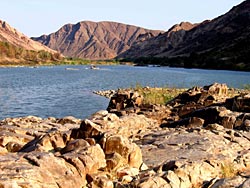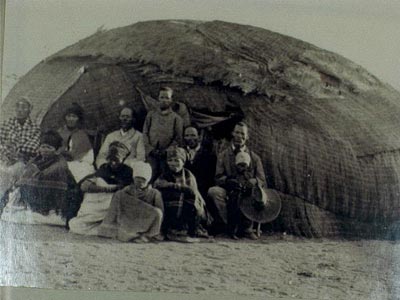| |
|
 |
|
The Richtersveld conservancy – the heart of a world heritage site nomination |
By Joani Cloete, Richtersveld Community Conservancy
[ Editors note: After submitting this article, the Richtersvelds just received more news. The conservancy was formally gazetted as a Heritage Area on 18 June 2007. Read more here. ]
The good news is that the Richtersveld Community Conservancy can be at the heart of a new World Heritage Site (WHS) not so far in the future.
 Fortunately, the WHS concept is nothing new to many of the Richtersveld People. Since 2000, there have been a number of workshops, discussions and meetings in the Richtersveld where the possibility was brought up of WHS status for the Richtersveld. These discussions are reflected in publications such as the Communal Property Association (CPA) Annual Reports, articles in the Richtersveld News, Conference Proceedings and the Integrated Development Plans of 2000, 2002, and 2003. NORAD field workers participated in courses on Robben Island, a WHS, and a study tour to Norway. In addition, three workshops were held in Sanddrift, Alexander Bay and Cape Town to discuss the realities of a WHS in the Richtersveld. These efforts generated great support for nominating part of the Richtersveld as a WHS. The question was then: Which part of the Richtersveld and on what grounds? Remember that WHS status means that the area must be of global importance, which is not easy to prove. Fortunately, the WHS concept is nothing new to many of the Richtersveld People. Since 2000, there have been a number of workshops, discussions and meetings in the Richtersveld where the possibility was brought up of WHS status for the Richtersveld. These discussions are reflected in publications such as the Communal Property Association (CPA) Annual Reports, articles in the Richtersveld News, Conference Proceedings and the Integrated Development Plans of 2000, 2002, and 2003. NORAD field workers participated in courses on Robben Island, a WHS, and a study tour to Norway. In addition, three workshops were held in Sanddrift, Alexander Bay and Cape Town to discuss the realities of a WHS in the Richtersveld. These efforts generated great support for nominating part of the Richtersveld as a WHS. The question was then: Which part of the Richtersveld and on what grounds? Remember that WHS status means that the area must be of global importance, which is not easy to prove.
A feasibility study was prepared by EcoAfrica, with proper consultation and participation of the Richtersveld Community, and the core area considered worthy of WHS status turned out to be the Richtersveld Community Conservancy. It was praised by the Department of Environmental Affairs and Tourism (DEA&T) as well as the World Heritage Committee of UNESCO. The result was the “go-ahead” to put together a full nomination file, also called a dossier. This dossier is an extensive compilation of written information, maps and photographs which provide proof that both the natural and cultural aspects of the Richtersveld are worthy of WHS status. EcoAfrica, who completed the feasibility study and was present at the many discussions in the Richtersveld Community around the nomination, was tasked with the job of compiling this large dossier.
 Prior to a possible decision in our favour by UNESCO, an evaluation mission needed to be conducted. The Evaluation Mission, by ICOMOS and IUCN, took place from 2 to 6 October 2006. ICOMOS evaluated the cultural aspects and IUCN the natural aspects. During this visit, the evaluators consulted with the community members in order to determine whether the local people are aware of the WHS process and if they care enough. This mission was a step in the process to evaluate the area and determine whether it contains the qualities proposed in the nomination dossier. These qualities are the cultural and biological heritage that is the pride of the Richtersveld Community. The Northern Cape Provincial Premier, Mr Dipuo Peters, also visited the Richtersveld during this period to assure the evaluators, as well as the community, of the Provincial Government’s support. Prior to a possible decision in our favour by UNESCO, an evaluation mission needed to be conducted. The Evaluation Mission, by ICOMOS and IUCN, took place from 2 to 6 October 2006. ICOMOS evaluated the cultural aspects and IUCN the natural aspects. During this visit, the evaluators consulted with the community members in order to determine whether the local people are aware of the WHS process and if they care enough. This mission was a step in the process to evaluate the area and determine whether it contains the qualities proposed in the nomination dossier. These qualities are the cultural and biological heritage that is the pride of the Richtersveld Community. The Northern Cape Provincial Premier, Mr Dipuo Peters, also visited the Richtersveld during this period to assure the evaluators, as well as the community, of the Provincial Government’s support.
ICOMOS and IUCN will give their final recommendations six weeks before the World Heritage Committee meeting, which will take place in July 2007. These recommendations will determine whether the Conservancy will become a WHS or not. Not later than two days before the World Heritage Committee meeting, the information needs to be verified to attend to factual errors, which will be confirmed by DEA&T. The World Heritage Committee will thus make its final decision at the meeting of July 2007 and immediately thereafter DEA&T will receive a letter which reflects this decision. If the Richtersveld Cultural and Botanical Landscape is approved as a WHS, it will be published on UNESCO’s World Heritage Centre.
 But what makes the Richtersveld so special? Many things, of course, but at the world level it is, in the first place, the enormous diversity of plants that occur in the Richtersveld. We have a bigger diversity of plants than any other desert in the world. But then one can also find unfamiliar cultures that live together here. The culture of the transhumance stock farmer, who moves between summer and winter stock posts, and uses a ‘matjieshuis’ to live in, is extinct almost everywhere else except here in the Richtersveld. What makes this transhumance lifestyle so special, especially at the global level? In the distant past, people lived like that, moving with nature and as nature determined—today, this does not exist almost anywhere else on Earth. But what makes the Richtersveld so special? Many things, of course, but at the world level it is, in the first place, the enormous diversity of plants that occur in the Richtersveld. We have a bigger diversity of plants than any other desert in the world. But then one can also find unfamiliar cultures that live together here. The culture of the transhumance stock farmer, who moves between summer and winter stock posts, and uses a ‘matjieshuis’ to live in, is extinct almost everywhere else except here in the Richtersveld. What makes this transhumance lifestyle so special, especially at the global level? In the distant past, people lived like that, moving with nature and as nature determined—today, this does not exist almost anywhere else on Earth.
The feasibility study also recommended that the process must first concentrate on declaring the Richtersveld Conservancy as a WHS. More pieces can be added at a later stage, even on the other side of the !Gariep, provided that they are special enough to be declared as a WHS.
Check out the brand new website about the Richtersveld. Visit the Richtersveld Community Conservancy’s website and the DLIST kiosks of the Richtersveld Municipality and the Eksteenfontein Tourism Office. Contact Joani Cloete at joani@richtersveld.net to hear more about the Conservancy and the WHS process, or to share your ideas. In the UNESCO’s World Heritage Centre you can find out more about World Heritage.
|
|
|